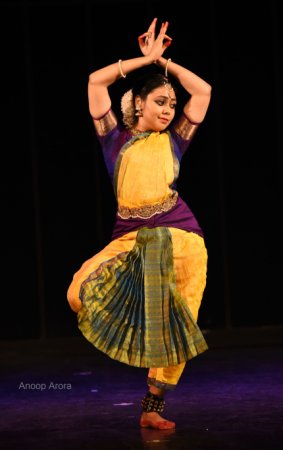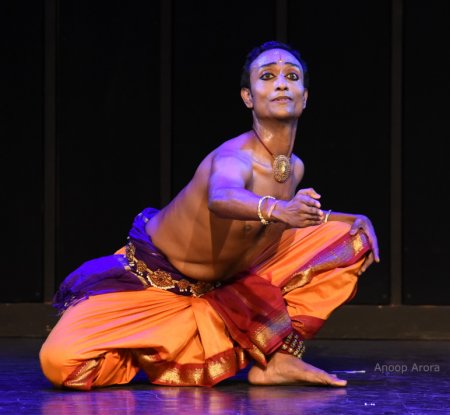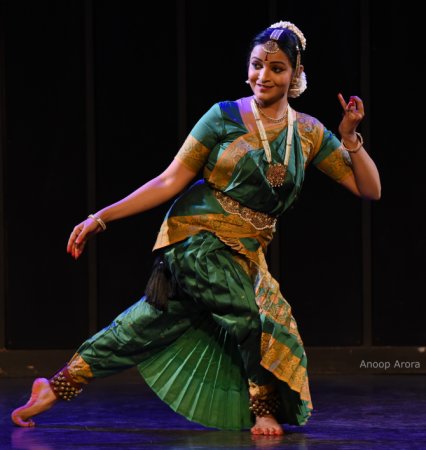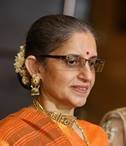
|   |

|   |
Energetic Bharatanatyam by Santanu Roy, Swati Atmanathan and Sayani Chakraborty - Shveta Arora e-mail: arorashveta1806@gmail.com Photos: Anoop Arora July 16, 2022 In the punishing heat of June in Delhi, there was some artistic relief in the form of a classical dance evening in Stein Auditorium presented by Bandish Arts and the India Habitat Centre. The dancers for the evening were Sayani Chakraborty, Santanu Roy and Swati Atmanathan. The stage had a ceremonial lamp and a flower rangoli in the foyer.  Sayani Chakraborty Sayani Chakraborty was the first to take the stage, in a yellow and purple costume. She is a disciple of Rama Vaidyanathan and did her early training under Rajdeep Banerjee. She presented a shabdam wherein the nayika is passionately in love with lord Shiva. She confides to her sakhi that she is in love with the dancing lord of Chidambaram. 'Will he ever realize my love for him? Will he ever be mine? I see him in my dreams and I see the sky as a manifestation of him. Will I ever have the good fortune of watching him dance the ananda tandavam at Chidambaram? Will my desires ever be fulfilled or am I foolish in dreaming about him?' Sayani portrayed the pining nayika as she talks to her sakhi. Her eyes were very expressive as she dreams of someday seeing and being in the embrace of Lord Sundareshwar. She portrayed the ananda tandavam of Lord Shiva. The interspersed nritta was neat with clean lines and stretches. The shabdam was a composition of Tanjavur Arunachalam Pillai, set to ragamalika, misrachapu talam, choreographed by Rama Vaidyanathan. The music composition was by M.L. Vasanta Kumar, vocals by Sudha Raghuraman, mridangam by Manohar Balatchandirane and flute by G. Raghuraman. The next piece was an ashtapadi from Gita Govinda by Jayadeva, set to ragamallika, adi talam. Radha ventures into the nikunj (bower) moving through the branches of trees. To her surprise and jealousy, she finds Krishna playing raas with other gopis and bestowing his love on them. She feels hurt and insulted. In an anguished state, she hides in the bower, but there are bees inside. As she sits there among the bees, she has dual emotions. On one hand, she is pained and anguished to see Krishna with other gopis and on the other, she cannot keep her eyes off his beauty. Radha admires his peacock feather, the kundal (earrings) on his cheeks, his clothes like a rainbow on a cloud due to his blue complexion. He is bejewelled from head to toe and his looks incite passion. Radha reminisces about the times she was with him. Sayani, through her abhinaya, depicted Radha lost in the memories of her union with him. She is carried away by the sound of the flute and thinks of his lovely face and lips. She shoos away the birds as they chirp for she wants to drown in the sound of the flute. As he dances, his curly hair, shown by flitting fingers, and peacock feather enchant her. His kundal caress his cheeks. The arms of the gopis are wrapped around him like creepers on a tree. The colours of his clothes and his jewels bedazzle her like the lightning. Radha gets ananda from the nectar of his feet and so does poet Jayadeva. The recorded music was sung by Sudha Raghuraman with flute by G. Raghuraman, and both were present for the show. Sayani's expressional prowess as an anguished and enamoured Radha was appealing. During her nritta for each refrain, she would show a different gesture and energy for rasa, and then freeze in a posture. She certainly shows the result of intense training under her guru and reflects her style. The next two performers for the evening were Santanu Roy and Swati Atmanathan. They founded Bandish Arts during the COVID-19 lockdown of 2020. Together, they proved how fit today's dancers are.  Santanu Roy The first piece was a dhwaja alarippu by Santanu Roy, a Kolkata based disciple of Samrat Dutta. The piece had been choreographed by his teacher with music by Shankar Narayanaswami. It was in talam chatushra jathi eka talam. The alarippu is the first part of the Bharatanatyam margam. It means 'blooming' and is an invocatory nritta piece. And here was an example of how the form can be tweaked to give it a different direction. This piece was choreographed to mark the 75th year of independence, and so the movements were changed to show a flag. Santanu, standing straight, swayed gently like a flag. The hands showed the ripples in the fabric of a flag in both directions and Santanu stood either straight, in araimandi or squat or one-legged squat, the other one folded to rest on the knee. It was a treat to watch. Swati Atmanathan, a Chennai-based disciple of Guru C.V. Chandrashekar, presented Ardhanareeshwar, a kriti by Muthuswami Dikshitar in ragam Kumudakriya, talam roopakam. The composition says 'I pray to you O Ardhanareeshwara, the one who is worshipped by the great saints.' His consort, his other half is Parvathi. He blesses with fearlessness and is adorned by the nagamani, he rides on Nandi, he is worshipped in the Aagam and Vedas and is served by Indra. Swati did a very energetic portrayal of the piece. In one of the adavus, she lifted one leg behind her in a seated position. She took stances for Ardhanareeshwar and concluded with a pooja and an aarti. During the piece, she did a jump and a half-split and then a full split. The hastas showed ardha chandra and chandrika. She had excellent control over her moves and adavus. The choreography and music composition both were by Guru C.V. Chandrashekar. Next, Santanu went on to perform a bhajan by Surdas, 'Jaya Narayana Brahma Paranarayana' dedicated to Vishnu. In this piece, there are three stories about Lord Krishna. The first is the birth of Krishna in the prison of Kamsa. The other two are about the vanquishing of the demons Bakasura and Kuvalayapeeda. The piece ends with dwikala jati showcasing the dashavatar. This was in ragamalika and talamalika. Santanu's strengths are his footwork and his hastas, which were very exact and neat. He started in a squat position, offering flowers, portraying dashavatar through gestures, and then Lord Vishnu reclining and Lakshmi at his feet. The Ramavatar was shown in a fight with Ravana. Krishna was born to Devaki maa in the prison and named Yadunatham. As the mother embraces her child, Vasudev is ready to take away the child as Kamsa sleeps. The child is put in a basket and his father carries him on his head. The rising Yamuna was shown with leg stretches and the wading of Vasudev through a river in the midst of a storm. The shesha (snake) comes to protect his lord from the torrential rains and Yamuna clears a path for them. And finally, he is laid to sleep next to Yashoda in Gokul. Krishna as a baby destroys the giant demon Bakasura as he comes in the form of a bagula or stork. Krishna opens his beak with both his hands and tears him apart. Kuvalayapeeda is the elephant who guards palaces in Mathura and Krishna kills him in a fist fight. Santanu's abhinaya for the entire sequence of events was quite appropriately done, going into the nuance of each tale. Praiseworthy was his act as Vasudev. Finally, he depicted the Kalki avatar. With the vocalist singing Jaya Narayan, Jaya Hari, vishwaroopam and chaturbhuj, Santanu prostrated himself. The choreography was by Samrat Dutta, music and mridangam by Shankar Narayanaswami, with nattuvangam by Mohana Iyer, vocals by Brinda Radhakrishnan, flute by Rupak Mukherjee and violin by Satyavishal.  Swati Atmanathan The final piece was a thillana by Swati in raga Hamsanandham, tala khanda triputa. The music and choreography were by Gurus C.V. Chandrashekar and Jaya Chandrashekar. The composition was an ode to the goddess in Varanasi, where Swati is from. Swati did backward leg stretches in all directions and covered the entire stage with expansive hand movements. Her countenance all throughout was pleasant. The lyrics and abhinaya praised Goddess Annapurneshwari as Vishwanatheshwari. It was quite a lilting piece. The compere for the evening was the pleasant Tanya Saxena. And the performers never flagged in energy.  Shveta Arora is a dance-mad writer who chronicles classical dance events in Delhi. Ten years ago, she started the blog Kala Upasana at delhiculturecomment.blogspot.com, where she began posting her own writing along with photographs clicked by Anoop Arora, her husband. She's been dancing all her life as a devotee, but resumed her formal training in Kathak in her 50s and has passed her fourth year Kathak exams. |